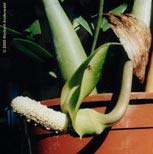2000
inflorescence
The inflorescence had no distinguishable scent or odour.
The spadix is not topped by a naked appendix (osmophore; in contrast to many of the "smelly" species, such as Amorphophallus, Sauromatum, Arum, ...), but the upper part is covered with male flowers up to the top.
Attempts were made to polliniate the female flowers with pollen from the male flowers once they had opened. Some female flowers started to swell to about twice their original size afterwards, but in the end the inflorescence turned dry without producing any fruits.
Photographs were taken on the day the spathe opened and about 2 or 3 days later; again about 3 weeks later, when the pollen was released (alas, I did not keep a diary...).
